Last Updated on January 24, 2024 by Greg Gillson
Have you marveled at the skill of an experienced birder who can instantly identify a bird glimpsed only briefly? You can learn how to identify birds. You can gain that skill. But it takes repetition.
The brain makes new pathways to make itself faster and better at performing tasks that you repeat. At a certain point you no longer have to think about the steps involved, you do it automatically.
In fact, the automatic processes of the brain take over so that you may be unaware, and unable to explain, just how you even perform a task. Identifying birds is the same. At first you struggle. Then one day, you just know how to identify birds.
Until you reach that automatic ease, though, exactly how can you identify wild birds?
You can identify birds by following this step-by-step method:
- Step 1. Size & Shape
- Step 2. Field Marks
- Step 3. Bill & Face
- Step 4. Color
- Step 5. Voice
- Step 6. Behavior & Habitat
- Step 7. Range & Seasonality
Following these steps in order will lead to the correct identification, more quickly and often.
 |
| White-crowned Sparrow. Greg Gillson. |
The good news is that all these items are listed in a field guide to the birds. So study the field guides and get out and look at lots of birds. That’s how you’ll learn.
A bright red bird with a crest is almost certainly a cardinal (steps1, 4). But most birds aren’t so obvious and unique.
The more of these steps match your bird, the more certain your identification. If any of the items don’t match, then you better take a closer look. It may be something else!
|
Need help identifying a bird? If you can’t figure it out yourself, you can have someone else try to identify a bird for you. If you have a detailed written description or a photo that you want someone else to identify for you, scroll to the bottom of this article and I’ll give you some places you can go for help.
|
How to identify birds
Use this 7-step method to identify birds.
Step 1. How to identify a bird by Size & Shape
You already know many birds by their shape. Thus, you already have the main foundation for identifying birds.
Crow. Pigeon. Duck. Chicken. Hummingbird. Gull. Robin. Cardinal. Jay. Chickadee. Pelican. Parrot. Hawk. Heron. Woodpecker. Do you know these major groups?
That’s about a third or a quarter of the groups you need to learn so that you can quickly place a bird into the correct group. That way you’re not searching through dozens of brown sparrow illustrations in your field guide when the bird is actually a wren.
Think silhouette. In fact, older field guides by one author had silhouette endplates. Very helpful.
In your local area there will be several common birds that can be a yardstick or benchmark for size comparisons with an unknown bird you see. These common birds will be different, depending upon where you live.
Size comparison is especially helpful if the bird you are comparing is actually present. Otherwise, you have to guess. People are notoriously bad at judging size and distance. So, it is best to compare size with something present.
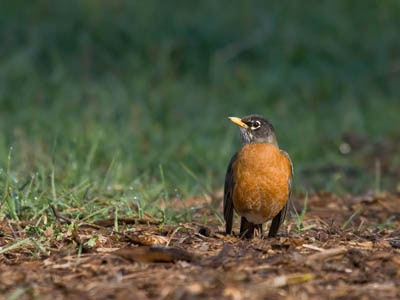 |
| American Robin. Greg Gillson. |
Common birds across the United States that may be used for size comparisons include American Goldfinches, House Finches, European Starlings, American Robins, Mourning Doves, American Crows, Red-tailed Hawks.
One thing to be aware of is the size measurement in the field guide. It is museum length. The length of a bird is measured from bill tip to tail tip of a dead bird laid on its back and stretched out straight. Birds are not measured like people. There is no “tall” measurement of a standing bird, feet to crown.
The length of a Black-bellied Plover and a Long-billed Dowitcher are both about 12 inches. The plover has a short bill. The bill of the dowitcher is about 4 inches long. Thus, though they are the same length, the plover is a much larger bodied bird.
Some field guides measure a bird’s weight. But many birds eat 1/4 or more of their weight each day. So this is only a very approximate average.
Sometimes tip-to-tip wingspan is listed in the field guides. This can help you compare the size of larger flying birds.
Rely more on the shape of a bird than its color. Noting size and shape keeps me from being misled by abnormal colors. See section on colors, below.
Step 2. How to identify a bird by Field Marks
In 1934 Roger Tory Peterson authored and illustrated a popular bird book known as a field guide.
A field guide to birds is a book used to help people identify living birds in the wild.
Birds illustrated in field guides are frequently stylized. They show larger plumage patterns that an observer may see from a distance. Fine details are left out of the illustration. Only the marks that are easily seen in the field are included, thus “field marks.”
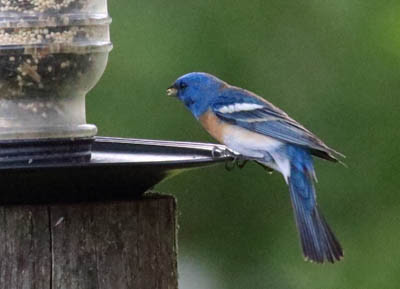 |
| Lazuli Bunting. Greg Gillson. |
Common field marks include contrastingly colored feathers such as eye rings, wing bars, and tail spots. But field marks can also include contrasting head, throat, breast, back, wings, belly, and tail patterns.
If a certain shape helps separate two similar birds, then they may be a field mark, too.
These would include things like the crest on the head of a red Northern Cardinal as opposed to the round head on the similar red Summer Tanager.
Another field mark is the pointed tail of the Mourning Dove compared to the square tail of many other doves.
Step 3. How to identify a bird by Bill & Face
Today’s optics, including cameras, spotting scopes and binoculars are much better than in the 1930s. Thus, we can often view birds with a very magnified image and maybe take a sharply focused picture with a telephoto lens.
Fortunately, at close range, most birds can be identified by the head and bill only!
The feathers on the head form about 15 named groups. There are several different crown stripes, several throat stripes. There are also standard patterns on the ear coverts and lower face. Learn these and you can identify those complex and uniquely patterned sparrow heads!
 |
| Song Sparrow. Greg Gillson. |
The parts of a bird and the major feather patterns are in the introduction of the field guides. This may be the most important part of a bird book. Don’t skip it!
Birds have many differently shaped bills or beaks. You may be aware of how the bill of a duck is different from the bill of a hawk, or woodpecker, or pelican.
But even among songbirds at your feeder there are many different types of bills. The bill of chickadees, wrens, warblers, sparrows, jays, and others all differ from each other.
The bill shape gets you to the main group of birds you are looking at. Then the exact pattern of feather coloration on the face will usually be enough to identify the exact species.
[See my article on bill shapes.]
Step 4. How to identify a bird by Color
Of the 1000 species birds found in North America, north of the Mexican border, you would be hard-pressed to find many that couldn’t be identified with a black-and-white photo.
Yet the first thing most people note is the color.
A thousand species. Half with the females colored differently than the males. A third where the summer and winter plumages are colored differently. That’s maybe 2200 differently colored plumages. Color alone is not enough to identify any bird!
That’s not to say that color isn’t important. Because it is. However, color helps identification most after you have used shape to get to the main group, such as thrush or finch or warbler.
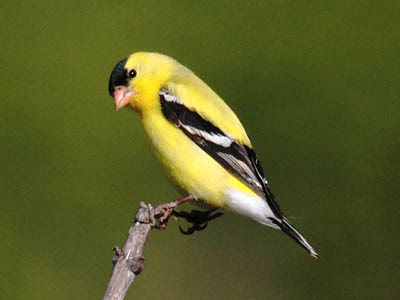 |
| American Goldfinch. Greg Gillson. |
And the placement of the color is important. So, knowing generally the difference between the crown, nape, throat, breast, belly, sides, vent, back, wing coverts, and rump is very helpful.
I have never found a bird book based on color to be very useful.
Also, beware of abnormally colored birds. I’ve seen birds discolored by genetics, paint, and pollen.
I’ve seen juncos with white heads. I’ve seen a gull spray painted bright orange. I’ve seen crows with white wings. I’ve seen a Bushtit on the coast with a yellow head from catkin pollen that might be mistaken for the desert Verdin.
Step 5. How to identify a bird by Voice
Many people really struggle to identify birds they only hear. Most birds have a simple main call. Some have distinctive notes only given in flight. And, of course, the songbirds have complex songs!
Each species of bird has a unique call and song that is possible for you to learn.
It is hard to describe bird songs and calls. Some people use English phrases to capture the cadence and general rising and falling notes of the song. The Killdeer and Pewee are named for their calls.
Some people hear and remember the song of White-throated Sparrow as a whistled Ole Sam Peabody. Others render it as Oh Sweet Canada. But this mnemonic doesn’t work for everyone. And it is easier to use this method after hearing it several times.
I think I had an advantage learning bird calls. I started watching birds in the forests of Oregon. My first encounter with a bird was often a song of an unseen bird I had to chase down through the woods.
Even today, more than 45 years later, when I hear a Black-headed Grosbeak sing, I envision that first singing bird I chased down. The brilliant orange and yellow and black and white bird was lit by the sun high in the maple tree. He threw his head back and issued that beautiful quick robin-like warble to the heavens. His bill opened and closed as he sang.
Bird voice recordings are available freely online now. When I was starting out, I had to go to the library to listen to a vinyl record of bird songs!
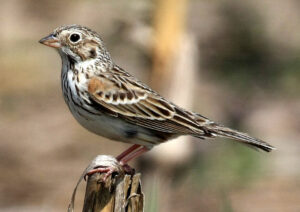
Step 6. How to identify a bird by Behavior & Habitat
Birds are very active creatures. So you will notice some behaviors that may help you identify a bird you see.
If a bird is swimming in the water, that can help you narrow down the possibilities. Loons, grebes, coots, ducks, geese, swans, gulls, petrels, albatrosses, cormorants, pelicans, auks, terns, and phalaropes swim regularly.
That’s still a lot. But you wouldn’t expect hummingbirds, woodpeckers, doves or many other groups of birds to be swimming.
If you see a bird walking down the trunk of a tree head-first, then it is one of the nuthatches or possibly a Black-and-white Warbler.
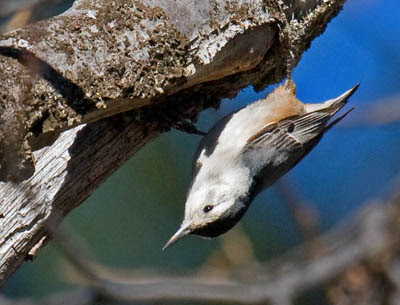 |
| White-breasted Nuthatch. Greg Gillson. |
Woodpeckers drum on hollow branches to create a territorial “song.” They hitch their way up a tree trunk using their tail as a brace.
Many groups of birds can be identified by the way they fly.
Some birds hover in place before diving for food. Some birds soar a long time without flapping. Some birds fly in zigzags. Some birds have deep wing strokes; some have very shallow wing strokes.
Some birds bob their heads as they walk. Others bob their tails.
The type of habitat where a bird lives can give a major clue about its identification. A good bird watcher learns the different local trees and major plant communities. Even a backyard feeder is a type of habitat with its own identifiable set of birds!
Some birds live only on the sea and adjacent shores; some birds are only found in fresh water. Some birds prefer conifer trees; others prefer deciduous trees. Some birds live in deserts. Some birds are found only in grasslands.
You look for Mountain Chickadees in high elevation conifer forests. You expect Black-capped Chickadees down lower in deciduous woods and backyards.
You expect Scrub Jays in oak trees. You expect Canada Jays in conifer forests. You expect Pinyon Jays in pine and juniper woodlands.
Pay attention to the field guide’s listing of habitats and any unique behaviors.
Step 7. How to identify a bird by Range & Seasonality
My first attempt at identifying birds was using a field guide to Eastern North America. I lived in the West!
The birds are different from place to place. Sure, Mourning Dove, Red-winged Blackbird, and American Robin are the same across the United States. But most birds in the West are not the same as birds in the East. Even if they are the same species, they may look slightly different.
The variety of birds is one thing that makes watching birds so enjoyable. But also challenging.
You must have a field guide that covers the birds in your local area. A continent-wide field guide is good if you want to be able to identify every bird you see.
Many bird books just for states cover only the most likely 100 or 150 species. This is good for casual bird watchers. But soon you will be seeing less common birds not in these beginner guide books.
Pay attention to seasonality. Some birds spend the entire year in your area. Others are found only in summer or winter. Some birds pass through in spring and fall only.
“Spring” migration can occur February through June, depending upon species. “Fall” migration can occur June through November. This also varies depending upon whether you live father north or south.
Pay close attention to the range and time of year that the field guide tells you.
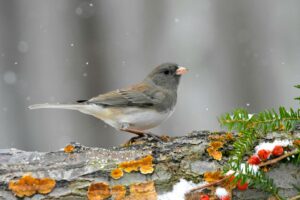
Help to identify a bird
If you can’t figure out what bird you saw, you can get help. If you have a picture of a bird you can identify it a couple of ways. Even if you only have a description, you may be able to learn the common birds that it is likely to be.
The first place I have for you is the Facebook Bird Identification Group. I’m not a Facebook user, but it seems to have an active community. Post your photo to the group with your location. From what I see, most people responding aren’t true experts. So you may get several wrong opinions before the correct identification is offered.
The best app for identifying birds is the Merlin App. It is a FREE app from The Cornell Lab of Ornithology. I tried it out a couple of years ago when it first came out and it was pretty good. It sometimes gave wrong answers. But it has improved much since then.
Answer some basic questions as to size, color, behavior (hmm… where have I heard that before?) and you will be given some possibilities. Or, submit your photo and the app will try to identify the bird for you. How long before the app is incorporated into the first pair of “smart” binoculars?
Learn about the Merlin app on its web page.
There are many local email bird lists you may join. Some are general birding related groups where you may ask about bird ID and discuss anything related to local birds and bird watching and bird walks. Others are restricted to only sharing rare bird sightings. Each group is different.
The American Birding Association maintains a list of bird watching mailing lists.
Wrapping Up
Estimating the exact number of birds in the USA is challenging due to their constant movement and varying populations across different species and habitats. However, here are some interesting facts about the amazing world of birds and bird watching.
In the US:
- Some studies like “How Many Birds Are There?” suggest a staggering 200-400 billion birds globally, potentially translating to 10-20 billion in the USA alone. This estimation considers individual lifespans and breeding cycles throughout the year.
- The House Sparrow is estimated to have a population exceeding 500 million in the USA, making it the most widespread bird.
- The USA boasts over 800 species of birds, showcasing a remarkable variety in size, plumage, and behaviors.
- Diverse habitats across the country nurture unique bird communities. From seabirds and shorebirds on the coasts to desert birds and raptors in the arid regions, and songbirds and waterfowl in various ecosystems, the variety is incredible.
- Hawaii, an isolated archipelago, showcases remarkable evolutionary adaptations with over 20 endemic bird species found nowhere else on Earth, like the iconic ‘I’iwi and the critically endangered Hawaiian Goose.
And the birds themselves:
- Hummingbirds as tiny marvels: These feathered jewels excel at hovering and have specialized beaks and tongues for sipping nectar from flowers.
- Woodpeckers and their drumming talents: Their strong bills and specially adapted skulls allow them to drum on trees efficiently, communicating and searching for insects hidden beneath the bark.
- Owls, the masters of silent flight: Their specialized feathers and wing structure enable silent flight, making them adept predators in the darkness.
- Shorebirds with incredible feats of migration: Some species undertake astonishing migratory journeys, like the Red Knot flying over 20,000 miles from South America to the Arctic tundra each year.
Frequently Asked Questions
Can Google identify birds?
Yes, Google can help you identify birds in a few different ways:
- Google Lens: This image recognition app can be used to identify birds from photos you take or ones you find online. Simply open the app, point your camera at the bird, and tap the search button. Google Lens will then try to identify the bird for you.
What is Audubon?
The National Audubon Society, often simply referred to as Audubon, is a non-profit environmental organization dedicated to conservation of birds and their habitats. Founded in 1905, it is one of the oldest and most effective such organizations in the Western Hemisphere.
Here are some key points about Audubon:
Mission and Activities:
- Conserves birds and their habitats: This involves activities like protecting endangered species, advocating for responsible land use policies, and restoring damaged ecosystems.
- Conducts research: Audubon scientists study bird populations, migration patterns, and threats to birds, providing valuable information for conservation efforts.
- Educates the public: Audubon offers educational programs for people of all ages, from school children to adults, to increase awareness and appreciation for birds and the environment.
- Advocates for policy change: Audubon lobbies for policies that protect birds and their habitats, working with government officials and lawmakers.
Who runs eBird?
eBird is a collaborative project managed by the Cornell Lab of Ornithology, a renowned center for bird research and education located at Cornell University in Ithaca, New York. However, it’s crucial to recognize that eBird wouldn’t function without the contributions of several key groups:
Cornell Lab of Ornithology:
- Provides overall leadership and management for eBird.
- Develops and maintains the eBird platform, including the website and mobile app.
- Analyzes and interprets eBird data for scientific research and conservation purposes.
eBird Staff:
- A dedicated team within the Cornell Lab specifically works on eBird, focusing on its development, user support, outreach, and data quality control.
- This team includes scientists, technicians, programmers, and educators.
Regional Partners:
- Collaborate with the Cornell Lab to establish and manage eBird regional portals in different countries and regions.
- These partners help tailor eBird to local needs and promote its use among birders in their respective areas.
Volunteer Reviewers:
- A network of dedicated volunteers across the globe help ensure the accuracy and quality of eBird data.
- They review bird observations submitted by users, flagging potential errors or inconsistencies.
Related Articles
Bird Watching Basics Series
- How to start bird watching
- How to identify a bird (this article)
- How to use binoculars for bird watching
- Tips for your first bird walk
Common identification challenges for beginners



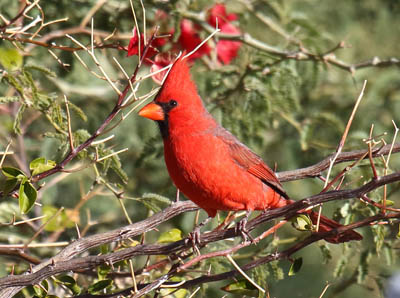
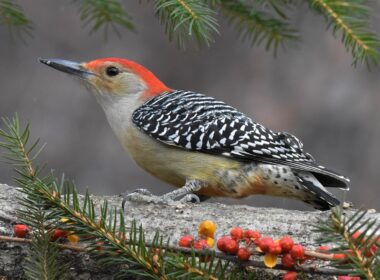
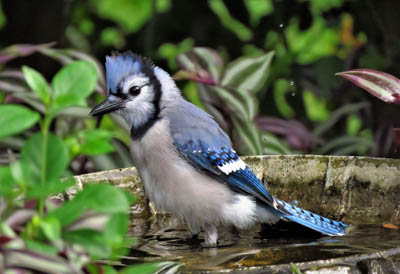
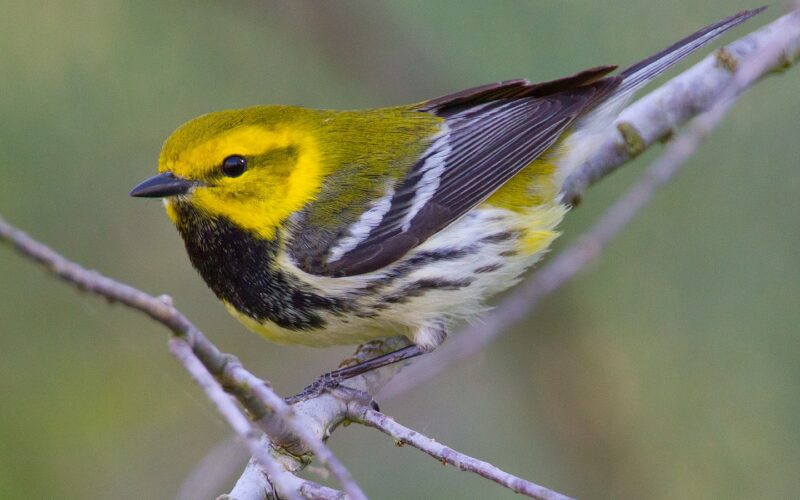
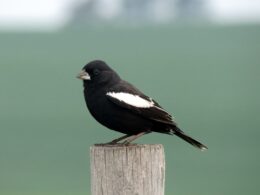
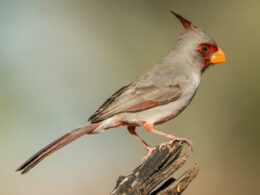
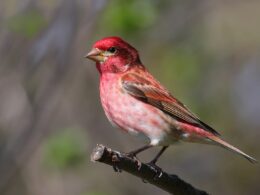
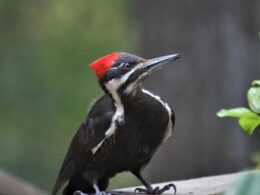
I would recommend that beginners like me should start differently. Step one should be: Guess who to expect to see. Make a list of 7 to 10 birds that are the most common for your location, season, and habitat. You can use any regional or local field guide, ebird, or just Google it. Then go out and look for them. Use the identification steps. Then after you get comfortable with your short list, add some more. If you get hooked, you will keeping adding to your list for a long time!
That is a great idea!
I have just such articles on this site for common backyard birds in every state. Each article lists 10 to 15 of the most common birds to expect.
You are right. Once a person gets hooked they don't stop!
hello blake
Hi are you able to identify this bird from Illinois?https://youtube.com/shorts/5ZzXhbkHMsU?feature=share
I'm bit late in responding, but the bird in the photo does appear to be an American Robin.